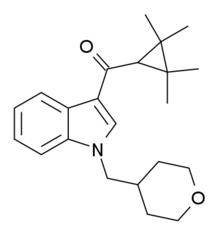A-834,735
 | |
| Identifiers | |
|---|---|
| |
| CAS Number |
895155-57-4 |
| PubChem (CID) | 11544639 |
| ChemSpider |
9719418 |
| ChEMBL |
CHEMBL271158 |
| Chemical and physical data | |
| Formula | C22H29NO2 |
| Molar mass | 339.48 g·mol−1 |
| 3D model (Jmol) | Interactive image |
| |
| |
| | |
A-834,735 is a drug developed by Abbott Laboratories that acts as a potent cannabinoid receptor full agonist at both the CB1 and CB2 receptors, with a Ki of 12 nM at CB1 and 0.21 nM at CB2. Replacing the aromatic 3-benzoyl or 3-naphthoyl group found in most indole derived cannabinoids, with the 3-tetramethylcyclopropylmethanone group of A-834,735 and related compounds, imparts significant selectivity for CB2, with most compounds from this group found to be highly selective CB2 agonists with little affinity for CB1. However low nanomolar CB1 binding affinity is retained with certain heterocyclic 1-position substituents such as (N-methylpiperidin-2-yl)methyl (cf. AM-1220, AM-1248), or the (tetrahydropyran-4-yl)methyl substituent of A-834,735, resulting in compounds that still show significant affinity and efficacy at both receptors despite being CB2 selective overall.[1][2][3][4][5]
Legal Status
As of October 2015 A-834,735 is a controlled substance in China.[6]
See also
References
- ↑ Dart M, et al. (2006). 1-Alkyl-3-keto-indoles: identification and in vitro characterization of a series of potent cannabinoid ligands. In 2006 Symposium on the Cannabinoids. International Cannabinoid Research Society: Burlington, VT.
- ↑ Poso, A.; Huffman, J. W. (2008). "Targeting the cannabinoid CB2 receptor: modelling and structural determinants of CB2 selective ligands". British Journal of Pharmacology. 153 (2): 335–46. doi:10.1038/sj.bjp.0707567. PMC 2219524
 . PMID 17982473.
. PMID 17982473. - ↑ Chin CL; et al. (January 2008). "Differential effects of cannabinoid receptor agonists on regional brain activity using pharmacological MRI". British Journal of Pharmacology. 153 (2): 367–79. doi:10.1038/sj.bjp.0707506. PMC 2219521
 . PMID 17965748.
. PMID 17965748. - ↑ Frost, J. M.; et al. (2008). "Indol-3-yl-tetramethylcyclopropyl Ketones: Effects of Indole Ring Substitution on CB2 Cannabinoid Receptor Activity". Journal of Medicinal Chemistry. 51 (6): 1904–12. doi:10.1021/jm7011613. PMID 18311894.
- ↑ Frost, J. M.; et al. (2010). "Indol-3-ylcycloalkyl Ketones: Effects of N1 Substituted Indole Side Chain Variations on CB2 Cannabinoid Receptor Activity". Journal of Medicinal Chemistry. 53 (1): 295–315. doi:10.1021/jm901214q. PMID 19921781.
- ↑ "关于印发《非药用类麻醉药品和精神药品列管办法》的通知" (in Chinese). China Food and Drug Administration. 27 September 2015. Retrieved 1 October 2015.